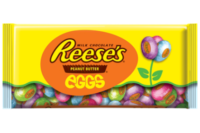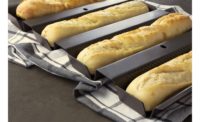A Shot in the Arm
By Pan Demetrakakes
and Andy Hanacek
and Andy Hanacek
In the business world, often a fresh perspective combined with a little investment can rescue a company from the doldrums of sluggish sales and slipping potential.
Last year, it became evident that iconic snack companies Jays Foods, Inc., and Lincoln Snacks needed a boost. That’s when an investment group formed Ubiquity Brands to turn around the fortunes of Jays, a regional salty-snack company based in Chicago. The purchase came in May 2004, a month after Jays declared bankruptcy, and a couple of months after Ubiquity had bought Lincoln, Neb.-based Lincoln Snacks, maker of popcorn-based treats Poppycock, Screaming Yellow Zonkers! and Fiddle Faddle.
Ubiquity is all over the rescue efforts — as the company’s name suggests — and has put into play a host of new products, new graphics and new management to resuscitate sales and hope for the futures of Jays and Lincoln Snacks.
“We named the platform company Ubiquity for a reason,” says Tim Healy, its chairman & CEO. “We’re looking to put product everywhere it makes sense. There are opportunities for us to put all of our products, across both companies, in many, many channels, in the right product and packaging forms and the right flavors. We’re trying to be extraordinarily innovative as it relates to expanding our portfolio.”
Without a doubt, Ubiquity’s efforts have been swift. It had been five years since Jays had a new, innovative product — until Sweet Baby Jays were launched in August 2004. The product is a different, yet simple extension of the Krunchers! kettle-chip line and offers two varieties: Unsalted and Mesquite.
“Our base product has two ingredients: sweet potatoes and corn oil,” Healy notes. “And the Mesquite BBQ has three: sweet potatoes, corn oil and the barbecue seasoning.”
Plus, he says, the natural healthfulness of sweet potatoes means the line can build upon current healthy-eating trends among consumers. Those who want a healthier kettle-cooked chip can look to this product.
“It’s a segment that is more healthful than regular potato chips,” explains Healy. “Sweet potatoes are on the South Beach Diet, [and] their caloric content is about 40% less than regular potato chips.”
Ubiquity also took aim at Lincoln Snacks from an innovation standpoint. It recently rolled out new Peanut Butter & Chocolate Poppycock, co-branded with Hershey Foods, which has the flavor of Reese’s Peanut Butter Cups. The company announced the launch of Belgian Dark Chocolate Just the Nuts as this article went to press. Additionally, since Ubiquity has stepped in, Lincoln has redone its packaging graphics and recently introduced a single-serve version of Poppycock.
But the revival doesn’t stop with new products. Improvements also are evident behind the plants’ walls. Ubiquity installed about $6 million worth of improvements at Lincoln, including new lines for processing and single-serve packaging. More than $17 million more will go for improvements to the Jays facility. Of that, about $13 million will go into the existing plant. Planned improvements include a robotic palletizer, better computer hardware and general upgrades to layout, parking lots, lighting and other basics. The remaining investment will fund the acquisition, gutting and refurbishing of a warehouse across the street.
The company had invested about $9 million at press time, Healy says, in those improvements and was on its way in building the new warehouse. Jays’ kettle-chip capacity was doubled and the packaging capabilities were completely overhauled. The company added four new kettles in January 2005 and three high-speed baggers and auto case-packers for the chip lines.
“We had room to double the kettle-chip capacity on Krunchers!, and we knew we were going to get that kind of growth,” Healy explains. “From a packaging standpoint, the packaging equipment was pretty antiquated.”
To top things off, Ubiquity is rolling out a redesign of its Jays graphics this summer when it launches four new chip products. Healy comments that the redesign isn’t anything radical, just “simplified, more uniform” to give the brand a better shelf impact. He noted that the new films were scheduled to hit the shelves around the time that this issue went to press.
Revamping its Distribution
The warehouse addition is the key part of a drive to improve Jays’ distribution. Under the current make-to-order system, most products go from the plant on Jays trucks to a dozen distribution centers in the upper Midwest. Once the new warehouse connected to the plant is up and running by January 2006, most of the final snack products will be stored there. Eight of the current 12 distribution centers will be converted to five cross-docking locations, and all route-truck orders for these locations will be picked at the plant itself.
Ubiquity targeted this change to build more direct-to-the-warehouse business as opposed to direct-store-delivery (DSD), and to focus more on private label. The system will accomplish three objectives, says Al Eisley, Ubiquity’s senior vice president for operations. It will improve inventory control, heighten productivity and reduce ongoing transportation costs.
“We’ll be able to reduce the number of over-the-road trucks that we send out of our production facility on a daily basis by 50%, by eliminating most of the remote warehouse stock replenishment we are doing today,” Eisley says.
Distribution is one of the most important bases for synergy between Jays and Lincoln, Healy adds.
“The synergies between the two companies are totally distribution-related,” he says. “It’s not a Jays and Lincoln issue. It’s a Ubiquity strategy.”
The biggest reason for the disparities in distribution is the difference in shelf life. Jays’ flagship fried chips have a shelf life of about eight weeks; Lincoln’s popcorn-based sweets can stay on store shelves up to a year.
As a result, Poppycock and other Lincoln Snack products have long been sold nationally, while Jays has been limited to a 10-state area centered on Illinois. But now the sister companies can benefit from each other’s distribution systems. Ubiquity plans to include Lincoln products on the Jays’ DSD runs. Conversely, Jays is working with some of the major retailers and club stores who currently handle Lincoln products.
It’s ‘Krunch’ Time
The key to this effort will be the marketing of Krunchers!, Jays’ line of kettle-cooked chips, as a national brand. Jays already has succeeded in putting Krunchers! on the national stage through Panera Bread Co., which uses the chips as a side for the sandwiches it sells in its 740-plus quick-service restaurants nationwide.
“Krunchers! is developing into a recognized brand name,” Eisley says. “You have to have one of those if you have national aspirations.”
Jays plans to expand retail distribution of Krunchers! westward to Denver — the first significant retail presence for a Jays product outside the upper Midwest. Two of Jays’ new chip products are Krunchers!: Sea Salt & Cracked Pepper, and Sweet Hawaiian Onion.
In fact, Jays’ Chicago heritage is one of the company’s biggest marketing assets, says Tom Reynolds, Ubiquity’s executive vice president for innovation.
“It actually amazed me how much our consumers own Jays,” Reynolds says. “They’ll tell you, ‘This is my hometown brand. I feel like since it’s made close by, it’s fresher tasting, and I love it.’”
“The [next] thing consumers told us is, Jays and ‘Can’t Stop Eating ’Em’ are synonymous,” he adds.
The graphics revamp for Jays products takes that heritage into account in subtle ways. On the back of the new bags is a prewar picture of a Jays truck being loaded and a brief company history. The front has a logo redesigned to incorporate that long-standing slogan: “Can’t Stop Eating ’Em.”
Another graphic change has to do with nutritional information. Jays has long touted on its labeling its use of corn oil, but focus groups made it clear that the average consumer didn’t realize the implications. To spell it out, Jays chips now sport a “0g Trans Fat” label.
Consumer input helped with the labeling of Lincoln Snack products, too. As part of a general graphics modernization, Lincoln quizzed people about its long-standing motto, “It’s the Nuts.” What they found is that consumers responded more to the candy glaze on Lincoln’s popcorn-based products than to the nuts, prompting a switch to, “It’s the Amazing Glaze.”
What’s Popping in Lincoln
Ubiquity Brands has been as good for Lincoln Snacks as caramel is for corn. Since buying Lincoln, Ubiquity has poured more than $6 million in improvements into its facility.
The new Peanut Butter & Chocolate Poppycock product came to fruition partly from a desire to reduce its dependency on tree nuts, whose prices have become notoriously volatile. But the new product required new equipment, including a chocolate temperer, which precisely controls the temperature and quality of the melted chocolate. It also required a learning curve, says Nils Gustafson, vice president for operations.
“There’s definitely a lot to learn about how to temper milk chocolate and apply it correctly,” he explains. “And then to get it to stick to the product is also one of the things we learned during our startup. You can get some great chocolate flowing out of your tempering unit, but if it doesn’t stick to the product, you can’t pack it out.”
Ubiquity announced that it will be selling Chocolate Poppycock year-round and will begin selling this fall a Belgian Dark Chocolate Just the Nuts.
The Lincoln plant roasts its own tree nuts, specifically peanuts, almonds and cashews. The glaze, called “candy” in plant parlance, is mixed in a separate staging area known as the “candy stand.” Ubiquity added PLC-based automation to the blending process. Workers still add butter and dry ingredients by hand, although Gustafson says that process will be automated soon, too.
The candy flows into a “concentrator,” one of a bank of heat exchangers that boils it down to its final form. Meanwhile, popcorn is being popped at about 10 lbs. per minute. After being sifted, the popcorn passes into a lugged conveyor. Depending on the product, it might receive a preliminary coating or be mixed with peanuts on the conveyor before entering a mixer for the main glaze.
Counter-rotating rollers level out the glazed popcorn kernels on a belt conveyor, which takes them through a wall into the cooling area.
The cooling tunnel consists of a double-pass system. When the plant is running Peanut Butter & Chocolate Poppycock, plant personnel open the back end of the cooler and wheel into place a short conveyor extension and portable enrober. The chocolate/peanut butter mixture is deposited, and the product is routed back into the cooler for the second half of the trip. This procedure keeps the coating in place.
Packaging takes place on six lines: one for bag-in-box, one for canisters, two for stand-up bags and one for the new single-serve Poppycock.
As part of the plant upgrade, Ubiquity completely automated the product system in the packaging area with horizontal-motion conveyors that allow operators to route product flow to any packaging line.
Lincoln Snack uses vertical form-fill-seal (f/f/s) baggers for its bag-in-box packaging. Two baggers feed a side-load cartoner that sets up and fills at a rate of 200 a minute. The cartons are coded and pass over a checkweigher.
The two stand-up bag lines use horizontal f/f/s systems, fed from combination weigh scales, which run at a rate of about 51 bags per minute. Vertical f/f/s systems feed the composite spiral-wound canisters and single-serve pouches.
On the single-serve line, product travels through a nine-pass cooler. The single-serve line provides a good example of how the Lincoln Snacks plant personnel move equipment around as needed. One of the two single-serve lines can also run bags for cartons. When it’s used for single-serve, a lane divider/collator is wheeled onto the end of the line. The collator deposits the single-serve bags in bunches of 10, the number in a case — making it easy for operators to quickly hand-pack the pre-counted bunch into cases.
The variety of stock-keeping units (SKUs) in flexible packaging rules out automatic case-packing for the near future.
Automatic case-packing does enter into the bag-in-box operation. Cases are automatically erected and side-loaded with 12 cartons per case before being automatically palletized and shrink-wrapped.
Lincoln Snacks’ products long 12-month shelf life provides flexibility in distribution. The plant aims to have at least 50% of each month’s inventory built up by the first of that month. Lincoln does some DSD, especially in Illinois, Indiana, Wisconsin and Michigan, where Jays has well-established routes. But the majority of its deliveries are to customer distribution centers.
Can’t Stop Making ’Em
With an influx of machinery as the result of sizable capital expenditures by Ubiquity Brands, the production floor at Jays Foods is a balance of old and new.
Potatoes are shipped via semi-trailer and dumped directly from the trucks, which often can be seen tilted high in the air by passing motorists on the neighboring interstate, into 12 bins. Depending on the time of year, Jays typically manufactures 8 to 14 bins full of potatoes per day.
Jays uses 100% corn oil on all its chips (except one old-fashioned style of chip that uses hydrogenated soybean), and receives one tanker-truckload of corn oil per day. According to Jeff Indovina, plant manager, that truckload can be used to process about 10 bins of potatoes.
When the potatoes arrive at the plant, employees take a sample of each truckload to be floated, cored and checked for defects. They then move on to one of Jays’ four potato peelers, one for Jays’ little-bag line and three for the Krunchers! and big-bag lines.
Solid waste and sludge water from the peeling process is treated, and filtered solid waste is sold as fertilizer. Residual starch from the entire chip-making process is also resold. All cardboard at the plant is reused.
After the potatoes are peeled, an employee inspects them on the line. Excess starch is washed off the potatoes, and they head to one of Jays four continuous lines or one of the plant’s 14 batch fryers.
After being fried, potato chips off both lines are quality-checked by an optic sensor and by pickers just before they hit conveyors to take them to packaging. Jays has in place accumulators, one of which is 90 cubic ft., to handle any backup of product prior to packaging.
The four continuous fryers feed 17 f/f/s baggers, which season the product, weigh it and drop it into bags. Cartons are manually packed and placed on a conveyor that takes them to be palletized. The continuous lines also have access to two of Jays’ new high-speed baggers and case-packers, which were added in January and April, respectively.
The batch fryers lead to seven dedicated f/f/s machines, of which three are high-speed baggers, and case-packing and cartoning are done automatically. Jays added four new kettles to the group in January.
Seasoning is stored in a separate room and is monitored on a FIFO (first-in, first-out) system. Jays carries about 20 seasonings at any given time. The quality control department inspects the seasonings upon arrival at the plant.
Currently, Jays’ docking area works as part-dock, part-temporary storage until the new warehouse opens. Amid stacks of product waiting to be loaded on trucks are six dock doors. Jays ships an estimated 190 truckloads per week in the summer and 160 loads per week in the winter.
Editor’s Note: Pan Demetrakakes is executive editor of Stagnito’s Food & Drug Packaging magazine.




